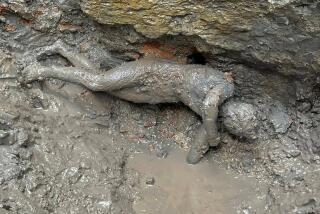Genetic tests: Italians were from Turkey
- Share via
Genetic studies of Italians in Tuscany show that their forefathers, the ancient Etruscans, moved to Italy from what is now Turkey -- an origin that many archeologists have dismissed as unlikely.
The Etruscans, who emerged about 1200 BC, reached their zenith in the 6th century BC, dominating Italy and the Mediterranean area until being assimilated into the Roman Republic about 200 BC. They provided many of the cultural underpinnings of Roman society. They were skilled metallurgists and masterful seafarers, but their origin has been a source of dispute for at least 2,500 years.
The ancient Greek historian Herodotus asserted that they came from Turkey, then called Lydia, but subsequent historians and modern archeologists have dismissed his claim.
A new study by geneticist Alberto Piazza of the University of Turin presented Sunday at the European Society of Human Genetics in Nice, France, however, is the third this year, and the strongest to date, linking the Etruscans to Turkey.
“We think that our research provides convincing proof that Herodotus was right,” Piazza said.
Others are not so sure.
“I guess I would have to say that I am unconvinced at this stage,” said archeologist Anthony Tuck of the University of Massachusetts at Amherst, who is excavating an Etruscan site in Italy. “It is premature to declare the issue resolved on our current understanding of this genetic evidence.”
Archeologist Jean Macintosh Turfa of the University of Pennsylvania’s Museum of Archeology and Anthropology was more dismissive. “There is really no sound archeological evidence that shows the influx of a big migration, or any kind of influx, from Asia Minor,” she said. “There is never a sharp break in cultures, no destroyed villages, etcetera.”
Turfa and Tuck hold to the view that the Etruscans evolved from the Villanovan culture, which emerged in central Italy. But the genetic findings will force a harder look at the evidence about their origins.
Tracing roots
Piazza and his colleagues studied the Y chromosome from males who had been living in selected areas of Tuscany between the Arno and Tiber rivers, notably Murlo, Volterra and Casentino, where the Etruscans were known to have concentrated. The men’s families had been living in the region for at least three generations and their surnames were Etruscan in origin.
The team compared the men’s DNA sequences with those from men in modern Turkey, northern Italy, the Greek island of Lemnos, the Italian islands of Sicily and Sardinia and the southern Balkans.
They found that the genetic sequences of the Tuscan men varied significantly from those of men in surrounding regions in Italy, and were most closely related to those of men from Turkey. “In Murlo particularly, one genetic variant is shared only by people from Turkey,” Piazza said.
Conventional genetic analysis indicated that the most recent common ancestors for the Turkish and Tuscan men lived about 3,500 years ago, Piazza said. That, in turn, would suggest that the Lydians were the forefathers of the Villanovan culture, so-named because the first remains of the early Iron Age culture were found at Villanova near Bologna.
Piazza said the team would now expand the analysis to include other men from Tuscany, and would also look at DNA from excavated Etruscan burials.
Geneticist Guido Barbujani of the University of Ferrara in northern Italy conducted an analysis of burials, and in a report in 2004 concluded that the Etruscans had, indeed, come from Turkey. That study, however, has been criticized by other experts, who say the minute amounts of DNA Barbujani obtained from Etruscan burials had been overwhelmed by modern-day DNA contamination -- a problem not unusual in such analyses.
And the women too
Earlier this year, geneticist Antonio Torroni of the University of Pavia -- who also participated in Piazza’s study -- and his colleagues reported on a study of mitochondrial DNA, which is passed through female lineages. They found that mitochondrial DNA from women in Tuscany was also most closely related to that from women in Turkey.
About the same time, geneticists Marco Pellecchia and Paolo Ajmone-Marsan of the Catholic University of the Sacred Heart in Piacenza reported on an analysis of mitochondrial DNA from the four ancient and unusual breeds of Tuscan cattle.
They concluded that the cattle were most closely related to cattle from the Near East, whereas other Italian breeds were more closely related to cattle from northern Europe, suggesting that the Etruscans brought them from Turkey.
All three studies seem to support the history written by Herodotus. He wrote that Lydia, on the southern coast of Turkey, suffered from a long-running famine. After 18 years, the Lydian king divided the population by lot and sent half under the leadership of his son Tyrrhenus to look for a better life.
The Tyrrhenians sailed from Smyrna, now Izmir, and eventually landed at Umbria, where they established a prosperous and rather liberated society, Herodotus wrote in the 5th century BC.
But historians, beginning in the 1st century BC with the Greek Dionysius of Halicarnassus, have doubted Herodotus, based at least in part on the mythological elements of his stories.
Linguist Rex Wallace of the University of Massachusetts also points out that the Etruscan language is definitely not of Indo-European origin, unlike Lydian.
“Recently published DNA studies tell us nothing about the origins and diffusion of the Etruscan language,” he said.





